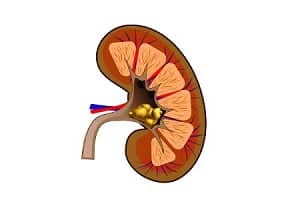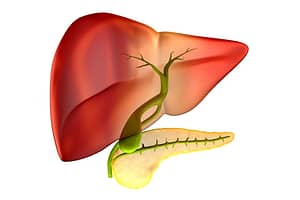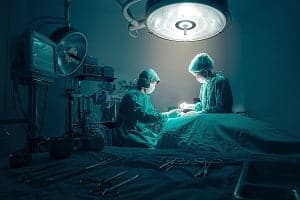
What are ovaries? What is ovarian cyst?
Ovaries are two small, bean shaped organs that are part of the female reproductive system, situated either side of the uterus (womb).
Two main functions of ovaries are to release an egg after every 28 days as part of the menstrual cycle and to release female sex hormones, oestrogen and progesterone , which play important role in female reproduction.
Cysts usually refer to fluid-filled sacs that are not a normal part of the tissue where they are found. These can develop in any part of the body. Ovarian cysts are the cysts that are found within or on the surface of an ovary.
What is the size of ovarian cysts? Are cysts on ovaries common and dangerous?
Most ovarian cysts are small and harmless. They occur most frequently during the reproductive years, but can affect women of any age. Most of the ovarian cysts are benign (non cancerous) and rarely it proceeds to malignant form.
Ovarian cyst may affect both ovaries at the same time, or may affect only one. They vary in size and may occur at different sites in the ovary. They are quite common and can occur both before and after menopause, though ovarian cysts are less common after menopause.
Postmenopausal women with cysts are at higher risk for getting ovarian cancer.
Many women develop these cysts at some time during their childbearing age. In most cases, these are harmless and doesn’t cause any discomfort and disappear after many menstrual periods or without needing any treatment, but in some cases they may require surgical removal. In rare cases a cyst that twists or ruptures may cause serious complications.
What are the different types of ovarian cysts?
Ovarian cysts can be classified broadly into two categories.
- Functional ovarian cyst
- Pathological ovarian cyst
In some women, the ovaries make many small cysts, a condition known by polycystic ovary syndrome (PCOS). PCOS can cause problem with ovaries and may also interfere with getting pregnant.
What are functional ovarian cysts?
These are the most common type of ovarian cysts. These develop as part of the normal menstrual cycle and are generally short-lived and harmless. Two most common types of functional ovarian cysts are the following:
Follicle cyst:
During a woman’s menstrual cycle, an ovary releases an egg each month. The egg grows inside a tiny sac called a follicle. When the egg matures, the follicle breaks to release the egg. Follicle cysts form if the follicle doesn’t break and open to release the egg resulting in follicle to continue growing into a cyst.
Follicle cysts often show no symptoms and disappear in one to three months.
Corpus luteum cyst:
Follicle sacs characteristically dissolve after releasing an egg into a mass called corpus luteum. However, sometimes the sac doesn’t dissolve completely and the opening of the follicle re-seals itself, additional fluid can build up inside the sac and this accumulation of fluid causes a corpus luteum cyst.
Most of these cysts resolve spontaneously. However, it may sometime rupture, or split to cause sudden pain and internal bleeding.
What are pathological ovarian cysts?
These types of cysts are not related to the normal function on your menstrual cycle. Most of these cysts are benign (non cancerous) in nature. They may happen because of overgrowth of cells or because of particular medical condition and include:
- Dermoid cysts: Also known as teratomas, come from cells present from birth and do not cause any symptom usually.
- Cystadenomas: Develop from the cells that cover the outer part of the ovary and contain watery fluid. Cystadenomas are usually attached to the ovary by a stalk.
- Endometriomas: They develop as a result of a condition known as endometriosis, where tissues grow outside the uterus. Some of the tissues can attach to your ovary and from a growth.
What are the signs and symptoms of ovarian cyst? What does it feel like when you have a cyst on your ovary?
Most ovarian cyst are small and don’t cause symptoms. An ovarian cyst will usually only cause symptom if:
- it ruptures or split
- it is very large
- it blocks the blood supply to the ovaries (torsions)
If a cyst does cause symptoms, you may have bloating, swelling, pressure, or pain in the lower abdomen on the side of the cyst. This pain may come and go and may be sharp or dull.
A sudden and severe pain is symptom of a ruptured cyst and if a cyst is causing twist of an ovary, you may have pain along with nausea and vomiting.
Some of the generalized symptoms of ovarian cyst include:
- Pelvic pain
- Pain during sex
- Breast tenderness
- Frequent urination
- Dull pain in the lower back and thighs
- Problems emptying the bladder or bowel completely
- Unexplained weight gain
- Pain during your period
- Unusual vaginal bleeding
Some prolonged symptoms may be associated with a condition called polycystic ovary syndrome (PCOS), a hormonal imbalance and other hormone related problems including obesity and infertility.
What are the causes of ovarian cyst?
Functional ovarian cysts often develop for no apparent reason in women who have monthly periods. There are many medical conditions which are supposed to be the causative agent for pathological ovarian cysts, for example, polycystic ovarian syndrome (PCOS) and endometriosis.
PCOS is a condition that causes lots of small, harmless cysts to develop on your ovaries. The cysts develop because of hormonal imbalance that is produced by the ovaries.
You may develop ovarian cysts, if you have endometriosis. Endometriosis is a condition where pieces of the tissue that lines the womb are found outside the uterus (womb) in areas such as the fallopian tubes, ovaries, bladder, bowel, vagina or rectum.
What are the risk factors for ovarian cyst?
Your risk of getting an ovarian cyst is intensified by:
- Hormonal problems: These include ingestion of medicine which is used to cause you to ovulate.
- Pregnancy: Sometimes, cyst formed at the time of your ovulation may stay on your ovary throughout your pregnancy.
- Endometriosis: If you have endometriosis, it increases the chance of developing ovarian cysts.
- A severe pelvic infection: If the infection spreads to the ovaries, it may cause formation of cysts.
- A history of previous ovarian cyst: If you had one before, you are likely to get more.
How is ovarian cyst diagnosed?
Most ovarian cysts often go undiagnosed since they do not cause any symptom. Sometime, they get diagnosed by chance – for example during pelvic examination. If your doctor thinks that you may have a cyst, the following tests may be recommended to find out more information:
Pregnancy test:
A positive test is suggestive of a corpus luteum cyst.
Ultrasound scan:
To confirm an ovarian cyst, you usually need to have an ultrasound scan. In this test, pictures of internal organs are created by using sound waves.
The views created by the sound waves show the shape, size, and location of the cyst. The view also shows weather the cyst is solid or filled with fluid.
Laparoscopy:
Your doctor can see your ovaries and can remove the ovarian cyst using an instrument called laparoscope, inserted into your abdomen through a small incision.
Blood test:
Your doctor may refer you for a blood test, if an ultrasound scan shows that cyst is partially solid, instead of being filled with fluid. This blood test will measure levels of a protein called CA25, which is often elevated in cases of an ovarian cancer.
What are the treatment options for ovarian cyst?
Most ovarian cysts go away without any treatment. Whether your ovarian cyst need any treatment is determined by your doctors, which will depend on:
- its size and appearance
- weather you have any symptom
- weather you have had menopause
Watchful waiting:
In the majority of the cases, a policy of “watchful waiting” will be recommended by your doctor where you receive no immediate treatment. This is because majority of cysts disappear after few weeks on their own. A follow up ultrasound scan will confirm the case.
Women, who have had their menopause, are at slightly higher risk of ovarian cancer, a regular ultrasound and blood test is recommended until the cyst disappears.
Medication:
Generally your doctor may prescribe hormonal contraceptives, such as birth control pills, to control recurrent ovarian cysts. However, birth control doesn’t have any effect on existing ovarian cysts.
Surgery:
If the cyst is large and causing symptoms, it usually needs to be removed. Removing it also reduces the risk of the cyst becoming cancerous later on.
Two types of surgical procedures are usually employed for the removal of ovarian cyst.
Laparoscopy:
In this surgery, the doctor makes a very small cut above or below your belly button to look inside your pelvic area and remove the cyst. This is often recommended for smaller cysts that look benign (not cancerous) on the ultrasound.
Laparotomy:
Your doctor may recommend this method if the cyst is large and may be cancerous. This surgery uses a larger cut in the abdomen to remove the cyst. The cyst is then tested for cancer. If it is likely to be cancerous, it is best to see a gynecologic oncologist, who may need to remove the ovary and other tissues, like the uterus.
How can ovarian cyst be prevented?
There is no way to prevent an ovarian cyst in an ovulating woman. Some doctors prescribe birth control pills to prevent recurrent ovarian cyst but it is not a permanent way to stop it.
However, regular pelvic examination will help in early diagnosis and treatment if needed. This can prevent future complications.
What are the complications of ovarian cyst?
Most ovarian cysts are small and benign and naturally go away on their own without needing any treatment. These cysts cause no or little symptoms. But in rare cases, your doctor may detect cystic ovarian masses that develop after menopause and might be cancerous.
Occasional complications associated with ovarian cysts include:
Ovarian Torsions:
This is a condition where large cyst causes an ovary to twist or displace from its original position. Blood supply to ovary is cut off, which results in onset of sudden and sharp pelvic pain with nausea and vomiting. If left untreated, it can cause damage or death of ovarian tissues.
Rupture:
Ruptured cysts are rare, but can cause intense pain and internal bleeding. The larger the cyst, the greater is the risk of rupture. Vigorous pelvis activity such as vaginal intercourse also increases the risk. This complication also increases the risk of infection and can be life-threatening if left untreated.






